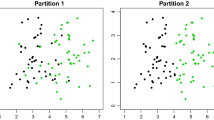Abstract
The prevalence of imperfections in data, characterized by uncertainty and imprecision, prompts the need for effective modeling techniques. The theory of belief functions offers a mathematical framework to address this challenge. In this paper, we tackle the problem of calculating the mean distance between elements of the same class, especially when class membership is uncertain and imprecise. Leveraging belief functions and a notion of similarity between elements, we propose a solution and validate its efficacy through experimental evaluations. The proposed method proves effective when labels exhibit low imprecision, whereas unsupervised methods may be more effective for labels closer to complete ignorance.
Access this chapter
Tax calculation will be finalised at checkout
Purchases are for personal use only
Similar content being viewed by others
Notes
- 1.
Homogeneity is represented by the mean distance between students of the same class.
- 2.
Grades are: \(A, A^-, B^+, B, B^-, C^+, C, C^-, D^+, D, D^-, F\).
- 3.
For the class that maximizes the pignistic probability, the mean distances are 9.3 for class 1 and 7.8 for class 2.
- 4.
The first class present in each dataset is always depicted.
References
Dempster, A.P.: Upper and lower probabilities induced by a multivalued mapping. Ann. Math. Stat. 38(2), 325–339 (1967)
Denœux, T., Kanjanatarakul, O.: Evidential clustering: a review. In: Huynh, V.N., Inuiguchi, M., Le, B., Le, B.N., Denoeux, T. (eds.) Integrated Uncertainty in Knowledge Modelling and Decision Making, pp. 24–35 (2016)
Hoarau, A., Martin, A., Dubois, J.C., Le Gall, Y.: Imperfect labels with belief functions for active learning. In: Le Hegarat-Mascle, S., Bloch, I., Aldea, E. (eds.) BELIEF 2022. LNCS, vol. 13506, pp. 44–53. Springer, Heidelberg (2022). https://doi.org/10.1007/978-3-031-17801-6_5
Jousselme, A.L., Grenier, D.: Éloi Bossé: a new distance between two bodies of evidence. Inf. Fusion 2(2), 91–101 (2001)
Jousselme, A.L., Maupin, P.: Distances in evidence theory: comprehensive survey and generalizations. Int. J. Appro. Reason. 53(2), 118–145 (2012)
Liu, Z., Pan, Q., Dezert, J., Martin, A.: Adaptive imputation of missing values for incomplete pattern classification. Pattern Recogn. 52, 85–95 (2016)
Masson, M.H., Denæux, T.: ECM: an evidential version of the fuzzy c-means algorithm. Pattern Recogn. 41(4), 1384–1397 (2008)
Shafer, G.: A Mathematical Theory of Evidence. Princeton University Press, Princeton (1976)
Smets, P.: Imperfect information: imprecision and uncertainty. In: Motro, A., Smets, P. (eds.) Uncertainty Management in Information Systems, pp. 225–254. Springer, Boston (1997). https://doi.org/10.1007/978-1-4615-6245-0_8
Zhang, Y., Destercke, S., Zhang, Z., Bouadi, T., Martin, A.: On computing evidential centroid through conjunctive combination: an impossibility theorem. IEEE Trans. Artif. Intell. 43, 487–496 (2022)
Author information
Authors and Affiliations
Corresponding author
Editor information
Editors and Affiliations
Rights and permissions
Copyright information
© 2024 The Author(s), under exclusive license to Springer Nature Switzerland AG
About this paper
Cite this paper
Hoarau, A., Thierry, C., Dubois, JC., Le Gall, Y. (2024). A Mean Distance Between Elements of Same Class for Rich Labels. In: Bi, Y., Jousselme, AL., Denoeux, T. (eds) Belief Functions: Theory and Applications. BELIEF 2024. Lecture Notes in Computer Science(), vol 14909. Springer, Cham. https://doi.org/10.1007/978-3-031-67977-3_22
Download citation
DOI: https://doi.org/10.1007/978-3-031-67977-3_22
Published:
Publisher Name: Springer, Cham
Print ISBN: 978-3-031-67976-6
Online ISBN: 978-3-031-67977-3
eBook Packages: Computer ScienceComputer Science (R0)




